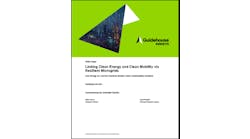Denmark has an ambitious target to produce 100 percent of its electricity from renewable sources by 2050. But integrating renewable energy into the system makes it difficult to balance the intermittent supply with demand.
With its high abundance of renewable energy, Bornholm Island, just south of Sweden, was the perfect test site for the European Union’s EcoGrid EU project. This set out to demonstrate the use of demand response to integrate renewable energy into the grid system.
The Bornholm microgrid
Home to 40,000 inhabitants, the island is connected to the Swedish electricity grid via a 60 kV AC cable, but can also operate in island mode — independent of the grid — if required.
The environmentally conscious community of this island started to think about renewable energy, and how to preserve their beautiful natural habitat, back in the early 1980s. Since then, they have been ahead of the curve on energy technology, creating a living microgrid demonstration lab.
The island currently has 16 MW of combined heat and power, 29 MW of wind, 6.5 MW of solar photovoltaics (PV), 2 MW of biogas as well as 34 MW of diesel and 25 MW of oil-fired steam generation for backup.
Handing over control
Traditionally, when electricity demand increases, additional generation is brought online to meet that demand. EcoGrid EU tested the impact of involving domestic and industrial customers to reduce consumption to balance the system.
The main focus was on electrical heating systems and heat pumps, as these are the biggest consumers in a Danish home. Control equipment designed to optimize these systems was fitted in the homes of around 2,000 participants.
The priority was to keep the customers happy; this started with setting the preferred temperature in their home. If the house was warm enough, and the electricity prices were high (implying a shortage of supply), the control system turned off the heat pump for a short period of time to reduce demand.
Customers could also view live electricity prices, allowing them to actively shift their consumption behavior accordingly. Some participants chose to do their laundry at night, when electricity prices were low.
Controls system challenges
“We ran into one big challenge; the home automation equipment that we installed was quite unstable,” explained Maja Felicia Bendsten, former EcoGrid EU project manager. “The connections were unstable. At any given time, one third of the population of participating houses was not controllable.”
Noisy vacuum cleaners, microwaves, and even certain types of bricks were found to interrupt the connection between the sensors and the gateway – the device that connects the home automation system to the cloud.
EcoGrid 2.0, the follow on project from EcoGrid EU, is working to resolve some of these issues.
Electric forklifts and manure mixers
Working with industrial customers was also a challenge. Most of the automation equipment operates as an on-off system, and the software in the controllers is proprietary, making it difficult to change set points.
“In the end, we controlled a few electric forklift chargers and some manure mixers for dairy farms,” Bendsten told Microgrid Knowledge.
To increase uptake from demand response, the industry needs to come up with standard protocols and more flexible automation equipment.
Motivating participation
Participation from the customers was key to the success of this project. A Danish electricity bill is made up mostly of taxes, which are unaffected by usage. Motivating people with money was not a viable option.
Thus, EcoGrid EU capitalized on the environmentally conscious, community oriented Bornholm culture and focused on the societal and environmental benefits of demand responseto engage participants.
Additionally, one of the benefits for participants was getting equipment installed that allowed them to remotely turn the heating on or off.
Future of the Bornholm Microgrid Lab
Completion of EcoGrid 2.0 is due in June 2019. So far, significant success has been demonstrated in carrying out demand response with domestic homes.
This paves the way for the future, helps Denmark to integrate renewable energy, and demonstrates the benefits of demand response to the rest of the world.
Bornholm Island is also experimenting with battery technology, electric vehicles as energy storage, and installing two large solar PV parks.
Track news about global microgrid projects. Subscribe to the free Microgrid Knowledge newsletter.






